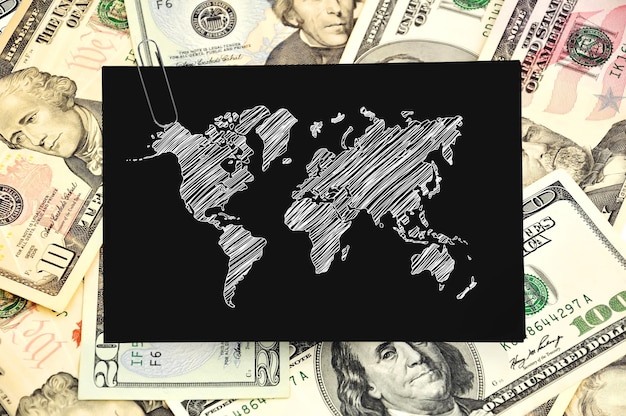The US Dollar’s Strength: Impact on International Trade in 2025

The US Dollar’s Strength: Analyzing Its Impact on International Trade in 2025 reveals how a strong dollar can reshape global commerce, influencing import/export dynamics and potentially triggering economic shifts across trading nations.
The strength of a nation’s currency is a key indicator of its economic health and global influence. In this article, we will explore the US Dollar’s Strength: Analyzing Its Impact on International Trade in 2025, examining how its value affects businesses, consumers, and international relationships.
Understanding the Factors Influencing US Dollar Strength
The strength of the US dollar is not determined in isolation. Multiple factors, both domestic and international, play a role in shaping its value on the global stage. Understanding these factors is crucial to anticipating future trends.
Economic Growth
A robust US economy often leads to a stronger dollar. When businesses are expanding and unemployment is low, demand for the dollar increases.
Interest Rates
Higher interest rates in the US attract foreign investment, increasing demand for the dollar and consequently raising its value. The Federal Reserve’s monetary policy plays a significant part here.
- Inflation Rates: Lower inflation rates can strengthen the USD, as it indicates a stable economy that can attract more foreign investment.
- Geopolitical Stability: The stability of the U.S. political landscape can affect investor confidence and the attractiveness of the dollar.
- Global Demand: As the world’s reserve currency, the dollar’s strength is partially determined by its widespread use in business and global transactions.
In conclusion, the strength of the US dollar is influenced by a complex interplay of economic growth, interest rates, investor confidence, and global political and economic stability. Monitoring these indicators provides insights into potential shifts in the dollar’s value.

The Direct Impact of a Strong Dollar on US Exports
A strong dollar can alter the dynamics of international trade, especially for US exports. While it signifies economic confidence, it can also make American goods and services more expensive for foreign buyers.
Decreased Competitiveness
When the dollar is strong, US products become more costly relative to those from countries with weaker currencies. This reduces the competitiveness of US exporters in international markets.
Reduced Demand
The higher cost of US exports can lead to decreased demand from foreign consumers and businesses, impacting the sales and profits of US companies.
- Impact on Businesses: Businesses highly dependent on exports will see potential declines in revenue.
- Sector-Specific Effects: Certain sectors, like agriculture and manufacturing, that greatly rely on exports can be significantly affected.
- Strategies for Mitigation: Companies may need to consider strategies to remain competitive, such as pricing adjustments or focusing on markets less sensitive to currency fluctuations.
In summary, a strong dollar poses challenges for US exporters, reducing their competitiveness and potentially decreasing international demand. Strategies to mitigate these effects are essential for businesses aiming to stay competitive in the global market.
How a Strong Dollar Affects US Imports
While a strong dollar can create challenges for exports, it often provides benefits for imports. The increased purchasing power helps to lower the costs of foreign goods, potentially benefiting consumers and industries that rely on imported materials.
Lower Import Costs
A strong dollar means that US businesses and consumers can buy goods and services from other countries at a lower price. This improves the affordability of imports.
Increased Purchasing Power
The increased purchasing power allows US companies to source materials and products more cheaply from abroad, leading to higher profit margins or lower prices for consumers.
- Consumer Benefits: Consumers may enjoy lower prices on imported goods such as electronics, clothing, and food.
- Business Advantages: US businesses can lower production costs by importing cheaper raw materials and components.
- Potential Drawbacks: Increased reliance on imports can sometimes affect domestic industries, leading to calls for protectionist measures.
In conclusion, a strong dollar benefits US imports by lowering costs and increasing purchasing power. While this can offer advantages to both consumers and businesses, it also raises concerns about the impact on US industries competing with cheaper imports.
Effects on Emerging Markets and Developing Economies
The strength of the US dollar has ripple effects that extend far beyond US borders, significantly impacting emerging markets and developing economies. These effects can range from increased debt burdens to altered investment flows.
Debt Burden
Many emerging markets hold debt denominated in US dollars. A stronger dollar increases the cost of servicing this debt, potentially leading to financial strain.
Investment Flows
A strong dollar can influence investment flows into and out of emerging markets. Investors may be attracted to the US due to the stronger currency, pulling capital away from developing economies.
- Capital Flight: Emerging markets may experience capital flight as investors move funds to the US seeking safer and higher returns.
- Currency Devaluation: To maintain competitiveness, some countries may devalue their currencies, which can lead to inflation and economic instability.
- Policy Responses: Emerging markets may implement measures such as raising interest rates or using foreign exchange reserves to stabilize their economies.
In summary, a strong dollar presents challenges for emerging markets and developing economies by increasing debt burdens and influencing investment flows. Policy responses are often necessary to mitigate potential negative impacts on their economies.

Strategies for Businesses to Adapt to a Strong Dollar
Given the potential impacts of a strong dollar, businesses need to adopt proactive strategies to navigate the changing economic landscape. These strategies can help mitigate risks and capitalize on opportunities.
Hedging Currency Risk
Businesses can use financial instruments like currency forwards and options to hedge against currency fluctuations. This helps stabilize revenues and costs.
Diversifying Markets
Expanding into new markets that are less sensitive to dollar fluctuations can reduce reliance on traditional export destinations.
- Pricing Strategies: Adjusting pricing strategies to remain competitive in international markets, such as absorbing some of the currency effects or offering discounts.
- Cost Management: Improving operational efficiency and reducing costs to offset the impact of a strong dollar on export prices.
- Supply Chain Optimization: Diversifying the supply chain to source materials from countries with weaker currencies can lead to cost savings.
In conclusion, to adapt to a strong dollar, businesses should employ hedging strategies, diversify markets, optimize pricing, manage costs, and enhance their supply chain. These measures can help sustain competitiveness and profitability in a challenging global environment.
Future Projections and Potential Scenarios for 2025
Looking ahead to 2025, several potential scenarios could influence the strength of the US dollar and its impact on international trade. Monitoring these trends is essential for businesses and policymakers.
Economic Forecasts
Economic forecasts suggest that the US economy will continue to grow, but at a potentially slower pace. This could affect the dollar’s strength depending on how it compares to other major economies.
Policy Changes
Changes in US trade and monetary policies, such as interest rate adjustments or new trade agreements, will have a significant impact on the dollar’s value.
- Technological Advances: The rise of digital currencies and blockchain technology could potentially challenge the dominance of the US dollar in international trade.
- Geopolitical Events: Unforeseen geopolitical events, such as political instability or trade wars, could cause major shifts in currency values and trade relationships.
- Global Economic Trends: The performance of other major economies, such as China and the Eurozone, will influence the relative strength of the US dollar.
In summary, the future strength of the US dollar and its impact on trade in 2025 will depend on economic forecasts, policy changes, technological advances, geopolitical events, and global economic trends. Staying informed about these factors is crucial for making strategic decisions.
| Key Point | Brief Description |
|---|---|
| 📈 Dollar Strength Factors | Economic growth, interest rates, and geopolitical stability influence USD. |
| 📉 Export Challenges | US exports face decreased competitiveness due to higher prices. |
| 💰 Import Benefits | US imports benefit from lower costs and increased purchasing power. |
| 🌍 Emerging Market Impact | Strong dollar can increase debt burdens and alter investment flows. |
Frequently Asked Questions
▼
The strength of the US dollar is influenced by economic growth, interest rates, inflation rates, geopolitical stability, and global demand for the dollar.
▼
A strong dollar makes US exports more expensive for foreign buyers, reducing their competitiveness and potentially lowering demand.
▼
A strong dollar lowers the cost of imported goods, increasing purchasing power for US businesses and consumers, leading to lower prices.
▼
A strong dollar can increase the debt burden for emerging markets with dollar-denominated debt and influence investment flows, potentially causing capital flight.
▼
Businesses can hedge currency risk, diversify into new markets, adjust pricing strategies, manage costs, and optimize their supply chains to adapt to a strong dollar.
Conclusion
In conclusion, the strength of the US dollar has wide-ranging impacts on international trade, affecting exports, imports, and emerging markets. Understanding these dynamics and adopting adaptive strategies is crucial for navigating the global economic landscape in 2025.





